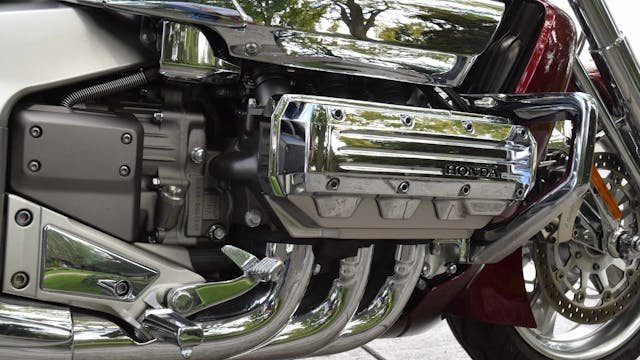Could this wild Honda cruiser Rune your bank account?
In a very general sense, those who enjoy the open road on two wheels tend to fall into two groups: custom builders and the finance-the-leather-jacket-with-the-bike owners. Outfits like Honda have regularly sought to blend the two together by building a factory custom. Something wild enough that the buyer doesn’t need to take the bike from the showroom straight to a custom shop to stand out from the crowd. The Honda Rune is one such attempt, and for one year only it was the wildest thing on the road.
Longer, lower, wider. Those are the three traits that customizers tend to emphasize when building a cruiser. Honda took that strategy to heart in 2004 when it built the Rune, a wild version of its Valkyrie model. At the time, Executive Vice President of Honda America, Ray Blank, said of the model, “We wanted to set the bar higher than ever, erecting standards that no one else had yet imagined, while also exploding old limitations on what an original equipment manufacturer could mass produce.”

In that, Honda undoubtedly succeeded. The Rune is an exercise in excess. Its flat-six engine is shared with Honda’s Goldwing model, displacing 1800 cc (111 cubic inches). That engine size lines up with the big-inch cruisers of the era, but triples the cylinder count. Six pistons, instead of the traditional two, bestow a jet-like engine tone to the Rune in a market filled with “potato-potato” machines. The engine was uniquely tuned for the Rune model and pumps out 118 horsepower and 123 pound feet of torque.

That is a lot of power, so this thing must be a rocket ship to ride, right? Sort of. Raw performance was not the Rune’s goal. The styling came first and foremost, which explains how the model somehow, in photos, hides its staggering seven feet of total length. It’s long. Heavy. As it rolled off the Marysville, Ohio, production line it scaled at 850 pounds. That is nearly a third of the weight of a brand-new Civic Sport. A sport bike this machine is not.
It did have sport-bike technology, though. While the single-sided swing-arm rear suspension has a scant 3.8 inches of travel, Honda Pro-Link technology (a proprietary suspension design that allows for a rising spring rate) helps improve ride quality. The front suspension is a bit of an optical illusion. The trailing-link design gives the look of a massive front rake—think Easy Rider chopper—but actually maintains conventional factory cruiser geometry for predictable and user-friendly handling. With a multitude of bushings and connections, the trailing-link system is complex, however, and likely factored into the considerable financial loss Honda suffered on each Rune sold.

Honda reportedly had $100,000 tied up in each Rune produced, which were then sold for $26,000. Even if it was intended as something of a loss leader, the Rune still wasn’t affordable in the greater marketplace. That relatively high price kept buyer interest low, even beneath what was necessary for the 1500 examples Honda projected it would build. Perhaps potential buyers preferred to wait for the depreciation to hit on used Runes and snap one up just a few years after the release.

“The Rune is another example of a a polarizing bike in its day that wasn’t too well received. At more than $25,000, the price was steep and the number of buyers was slim,” says Hagerty valuation analyst and bike enthusiast James Hewitt. “Despite slow sales, the bike managed to capture interest from those who wanted to wait for used prices to drop, and when you have a cult following and people waiting for used prices to drop they don’t drop too far. Prices bottomed around 2012 (Honda was still selling new old stock ones in 2008 and 2009) and have remained strongly in the mid teens since.”
All that said, the Rune is a fascinating tribute to custom bike culture that came with the backing of a reliable manufacturer like Honda. As of this writing, a solid Rune runs between $15,000 and $18,000 on average. Sport bikes of the 1980s and ’90s are gaining popularity and therefore some collectibility, but oddities like the Rune stand out and have already made the leap in the market to reflect that reality. It may not have been a hit when it launched, but the Honda Rune is having the last laugh.



